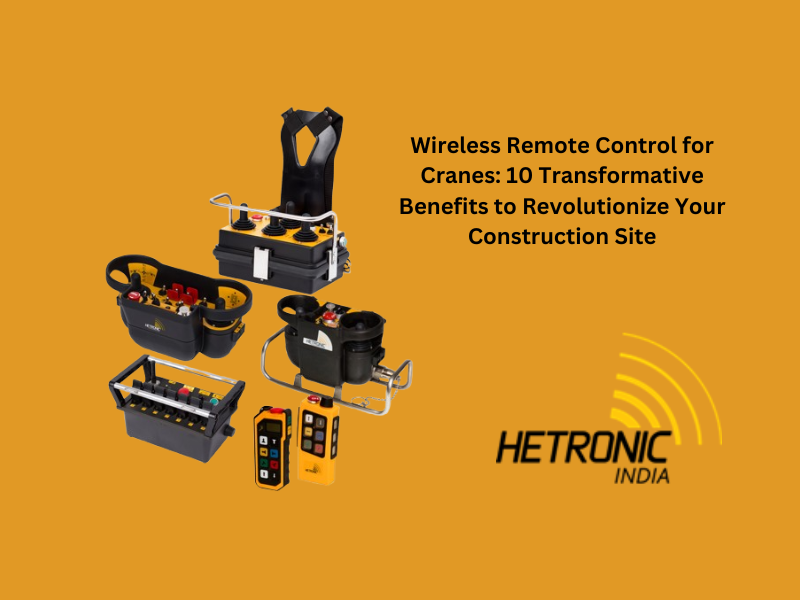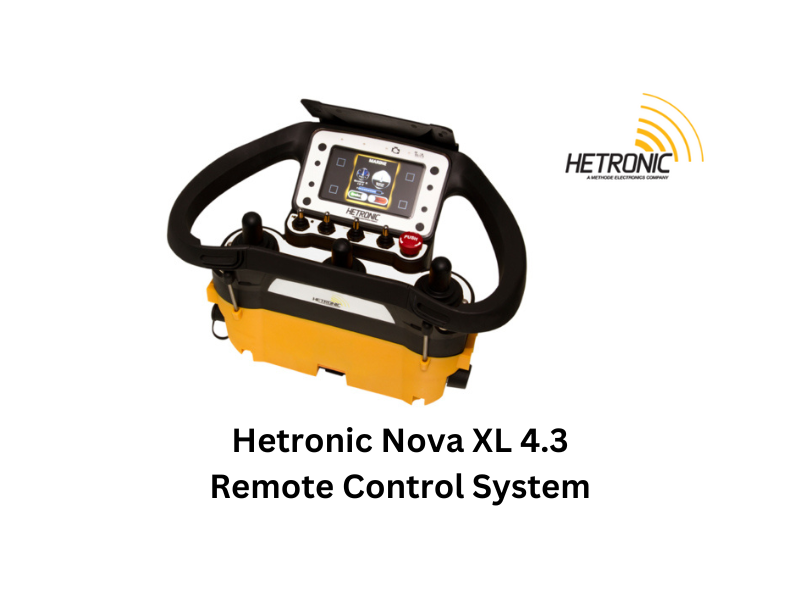Introduction – Wireless Remote Control for Cranes
In the ever-evolving world of construction and industrial operations, staying ahead of the curve is not just an advantage—it’s a necessity. Enter the game-changer: wireless remote control for cranes. This cutting-edge technology is not just a fancy add-on; it’s revolutionizing how we approach crane operations, safety, and efficiency. But what makes these systems so special? How can they transform your worksite? And most importantly, why should you care?
In this comprehensive guide, we’ll dive deep into the world of wireless remote control for cranes. We’ll explore their inner workings, uncover their numerous benefits, and address the burning questions you might have.
Whether you’re a construction manager looking to boost productivity, a safety officer aiming to reduce risks, or a business owner seeking to maximize ROI, this article is your ultimate resource.
So, buckle up and prepare to discover how wireless remote control for cranes are not just changing the game—they’re redefining it entirely.
What Are Wireless Remote Control for Cranes?
Before we delve into the myriad benefits and applications, let’s establish a clear understanding of what wireless remote control for cranes actually are.
Wireless remote control for cranes are advanced lifting systems that allow operators to control crane functions from a distance using a handheld remote device. This remote communicates with the crane’s control system via radio frequency (RF) or infrared (IR) signals, eliminating the need for direct physical contact or proximity to the crane.
Key Components:
- Transmitter (Remote Control): The handheld device used by the operator to send commands.
- Receiver: Mounted on the crane, it interprets signals from the transmitter.
- Control System: Translates received signals into actions performed by the crane.
- Safety Features: Emergency stop buttons, signal encoding, and other protective measures.
Now that we have a basic understanding, let’s explore the transformative benefits these systems bring to the table.
1. Enhanced Safety: Your Top Priority, Addressed
Safety isn’t just a buzzword—it’s the cornerstone of any successful operation. Wireless remote control for cranes take safety to unprecedented levels:
– Distance from Danger: Operators can control the crane from a safe distance, away from potential hazards like falling objects or unstable loads.
– Better Visibility: Without the constraints of a fixed cabin, operators can position themselves for optimal views of the load and surrounding area.
– Reduced Fatigue: Less physical strain on operators leads to fewer errors and accidents.
Statistical Insight: According to a study by the Construction Industry Institute, sites using wireless remote control for cranes reported a 40% reduction in crane-related incidents.
2. Increased Productivity: Do More in Less Time
Time is money, and wireless remote control for cranes help you make the most of both:
– Faster Operations: Quicker setup and more precise control lead to faster load movements.
– Reduced Downtime: Less time spent on operator changes and position adjustments.
– Multi-Tasking Capability: Operators can perform other tasks when not actively controlling the crane.
Statistical Insight: On average, construction sites report a 25-30% increase in crane operation efficiency after switching to wireless remote control for systems.
3. Cost-Effectiveness: Boost Your Bottom Line
While the initial investment might seem significant, the long-term savings are substantial:
– Reduced Labor Costs: Fewer personnel required for crane operations.
– Lower Insurance Premiums: Improved safety records often lead to reduced insurance costs.
– Decreased Maintenance Expenses: Less wear and tear on equipment due to more precise operations.
4. Improved Precision: Millimeter-Perfect Control
Precision isn’t just about accuracy—it’s about confidence in every move:
– Fine-Tuned Movements: Joysticks and buttons allow for minute adjustments.
– Load Stability: Better control means less load swinging and reduced risk of accidents.
– Optimal Positioning: Operators can place loads exactly where they’re needed, reducing additional handling.
5. Enhanced Flexibility: Adapt to Any Situation
Flexibility in crane operations translates to adaptability in project execution:
– Multiple Control Points: Operators can move to the best vantage point for each lift.
– Easy Handovers: Seamless transfer of control between operators during shift changes.
– Adaptability to Site Conditions: Overcome line-of-sight issues and other physical barriers.
6. Improved Ergonomics: Comfort Meets Productivity
Happy operators are productive operators:
– Reduced Physical Strain: No more long hours in cramped crane cabins.
– Customizable Controls: Adjust sensitivity and layout to individual preferences.
– Weather Protection: Operate in comfort regardless of external conditions.
7. Advanced Data Logging and Analytics: Informed Decision-Making
Knowledge is power, especially when it comes to optimizing operations:
– Performance Tracking: Monitor and analyze crane usage patterns.
– Maintenance Predictions: Anticipate equipment needs based on usage data.
– Safety Compliance: Automated logging for regulatory requirements.
8. Enhanced Communication: Keep Your Team in Sync
Clear communication is the key to smooth operations:
– Integrated Communication Systems: Some remotes include built-in walkie-talkie functions.
– Visual Feedback: LCD screens can display critical information to operators.
– Real-Time Alerts: Immediate notification of potential issues or hazards.
9. Scalability and Integration: Grow Without Growing Pains
As your operations expand, your crane control system can grow with you:
– Multi-Crane Control: Manage multiple cranes from a single remote.
– Integration with Other Systems: Connect with inventory management or project planning software.
– Upgradeable Software: Easily update features and capabilities as technology advances.
10. Environmental Benefits: Green Operations for a Sustainable Future
Sustainability isn’t just good for the planet—it’s good for business:
– Reduced Fuel Consumption: More efficient operations mean less energy use.
– Decreased Emissions: Less idling and more precise movements reduce overall emissions.
– Noise Reduction: Remote operation can allow for quieter worksites, especially beneficial in urban areas.
Frequently Asked Questions
Q1: How safe are wireless remote control for cranes?
A: Extremely safe. These systems come with multiple safety features including emergency stop buttons, signal encryption to prevent interference, and automatic shut-off if the remote goes out of range. Many models also include load moment indicators and anti-collision systems.
Q2: What’s the range of a typical wireless remote control for cranes?
A: The range varies by model, but most systems can operate effectively from 100 to 300 meters (328 to 984 feet). Some high-end models can reach up to 500 meters (1640 feet) or more.
Q3: Can wireless remote controls be used on existing cranes?
A: In many cases, yes. Many manufacturers offer retrofit kits that can be installed on existing cranes. However, the feasibility and cost-effectiveness depend on the age and model of the crane.
Q4: What happens if the remote loses connection with the crane?
A: Safety first! Most systems are designed to automatically stop all crane movements if the signal is lost. Once the connection is re-established, the operator typically needs to perform a specific action to resume control.
Q5: Are there any weather limitations for wireless remote controls?
A: Modern wireless remote controls for cranes are designed to operate in a wide range of weather conditions. They’re typically water-resistant and can function in temperatures from -20°C to +55°C (-4°F to 131°F). However, extreme conditions may affect battery life or signal strength.
Q6: How long do the batteries in the remote control last?
A: Battery life varies by model and usage, but most modern remotes can operate for 8-12 hours on a single charge. Many systems come with rechargeable batteries and charging stations for continuous operation.
Q7: Is special training required to operate a wireless remote control crane?
A: Yes, operators should receive specific training on the wireless control system in addition to their standard crane operation training. Many manufacturers offer training programs, and it’s essential to follow all local regulations regarding crane operator certification.
Q8: Can wireless remote controls be used for all types of cranes?
A: While wireless remote controls are incredibly versatile, their suitability depends on the specific crane type and application. They’re commonly used with tower cranes, mobile cranes, and overhead cranes, but it’s best to consult with manufacturers or experts for your specific needs.
Q9: How do wireless remote controls impact insurance rates?
A: Many insurance companies offer reduced rates for cranes equipped with wireless remote controls for cranes due to their enhanced safety features. However, this can vary by insurer and location, so it’s best to check with your specific provider.
Q10: What’s the typical return on investment (ROI) for implementing wireless remote control systems?
A: While the exact ROI can vary based on usage and specific circumstances, many companies report recouping their investment within 12-18 months through increased productivity, reduced labor costs, and fewer accidents.
The Future of Crane Operations: What’s on the Horizon?
As we look to the future, the potential for wireless remote control cranes becomes even more exciting. Here are some trends and innovations to watch:
Integration with Virtual and Augmented Reality
Imagine operators wearing AR glasses that overlay critical information onto their field of view, or using VR for advanced training simulations.
Artificial Intelligence and Machine Learning
AI could help optimize crane movements, predict maintenance needs, and even assist in load balancing and route planning.
Autonomous Operations
While fully autonomous cranes are still on the horizon, semi-autonomous features like automated path planning and collision avoidance are becoming more common.
Enhanced Connectivity with IoT
The Internet of Things (IoT) could allow for seamless integration of crane operations with other aspects of construction or industrial processes, leading to smarter, more efficient worksites.
Improved Energy Efficiency
As battery technology advances, we may see more electric cranes with longer operating times and faster charging capabilities.
Making the Switch: Implementation Strategies
If you’re convinced that wireless remote control for cranes are the way forward for your operations, here are some steps to help you make a smooth transition:
- Assess Your Needs: Evaluate your current operations and identify areas where wireless control could have the most significant impact.
- Research and Compare: Look into different manufacturers and models to find the best fit for your specific requirements.
- Plan for Training: Develop a comprehensive training program for your operators and maintenance staff.
- Start Small: Consider implementing the technology on one crane first as a pilot project.
- Monitor and Adjust: Closely track performance metrics and gather feedback from operators to fine-tune your implementation.
- Scale Up: Once you’ve optimized your processes, roll out the technology across your fleet.
- Stay Updated: Keep abreast of new developments in the field and be prepared to upgrade as new features become available.
Conclusion: Elevate Your Operations with Wireless Remote Control for Cranes
In the fast-paced world of construction and industrial operations, staying ahead means embracing technologies that offer tangible benefits in safety, efficiency, and cost-effectiveness. Wireless remote control for cranes are not just a trend—they’re a transformative force that’s reshaping the industry.
From enhanced safety and increased productivity to improved precision and environmental benefits, the advantages of these systems are clear and compelling. As we’ve explored in this comprehensive guide, the potential impact on your operations can be significant and far-reaching.
But perhaps the most exciting aspect is the future potential. As technology continues to evolve, the capabilities of wireless remote control for cranes will only expand, offering even more opportunities for innovation and improvement.
So, ask yourself: Can you afford to be left behind in this technological revolution? The cranes of tomorrow are here today, and they’re wireless. It’s time to take control—remotely.





